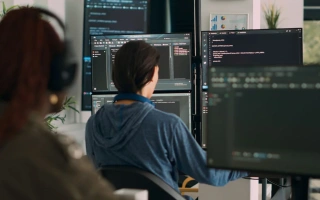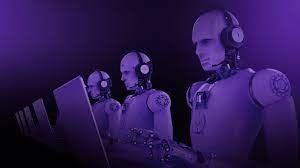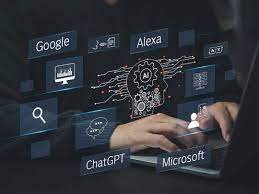In an era where digital is becoming commonplace, innovation creates new competitive advantages for businesses. How to competently build an innovation development program and evaluate the effect of its implementation?
About the expert: Alexander Bogutsky, chief manager of the “Cultivation of Innovation” program at IT_One.
Could it be too late tomorrow? Innovation as the driving force of business
In the 1980-90s, the VUCA concept arose in scientific circles close to the American military structures, the defining idea of which was the instability, uncertainty, complexity and ambiguity of the model of the surrounding reality. In the late 2000s, this concept, which largely challenged traditional ideas about the world order, began to actively take root in the corporate environment. Managers in business practices have adopted the idea of a world whose key attributes are variability ( Volatility ), uncertainty ( Uncertainty ), complexity ( Complexity ) and ambiguity ( Ambiguity ).
This concept was widely used until 2020, until events related to the pandemic and its consequences made adjustments to it. Then VUCA was replaced by the acronym BANI, which more accurately characterizes the “new normal”: fragile ( B rittle), alarming ( A nxious), non-linear ( N on-linear), incomprehensible ( Incomprehensible ).
According to the BANI concept, we do not and cannot have a model that gives a complete understanding of what is happening, and, accordingly, methods that guarantee the accuracy of forecasts and decisions.
The modern world is prone to absolutely unexpected and abrupt changes, to abrupt and unpredictable transformation. But we have the opportunity to understand which management approaches and thinking models are effective in the new reality, and which will limit us.
The key skill for effectiveness in new conditions is not the ability to plan and make forecasts, but the ability to quickly recognize changes and find solutions adapted to them.
In such a paradigm, innovative thinking and innovation become success factors, and sometimes the only condition for survival. We need the ability to operate with a flexible picture of the world, adaptively change mental models and find solutions to problems that seemed impossible just yesterday.
If you do not develop innovations today, tomorrow may be too late. According to the Accenture Technology Vision 2021 report , based on a survey of more than 6 thousand business and IT leaders, companies that use effective digital platforms and quickly adapt to innovation grow revenue five times faster.
At the same time, due to the development of visual programming platforms and special systems based on artificial intelligence, the ability to create and develop digital solutions becomes available to employees performing business functions, that is, not to IT specialists. Information technology is no longer the domain of narrow professionals. What trump cards then remain for specialized IT companies?
Thanks to innovation, the company achieves a number of goals
Ensuring sustainable business growth in new conditions.
Finding a market niche and new competitive advantages in the post-digital era.
Responding to changing customer needs: forecasting and modeling demand, a flexible approach to the development of goods and services.
Qualitative improvement of personnel, creation of a positive image. The most qualified personnel, carriers of an innovative culture, are more willing to work for a company that has experience in innovation.
Simply put, innovation brings profit. This is not only and not so much about the development of new projects, spin-offs, and startups. The focus is on the task of being able to effectively grow a business in a changing reality, timely find successful answers to unexpectedly emerging new challenges, constantly generate and competently implement new ideas.
Innovation matrix: defining goals and choosing a strategy
According to one of the definitions accepted in international practice, innovation is the final result of innovative activity, embodied in the form of a new or improved product introduced on the market, a new or improved technological process used in practical activities or in a new approach to social services. Simply put, innovation is an innovation that has been introduced and ensured a qualitative increase in the consumer qualities of a product or the efficiency of its creation processes .
There is no universal algorithm or universal tools that will ensure the effectiveness of corporate innovation. Each organization has its own specifics, tasks and capabilities. Accordingly, in order to select the most suitable model, it is necessary to decide what goals the company intends to achieve and what resources it can devote to this.
To determine strategic goals in the field of innovation, well-known strategic management tools are applicable. And to identify possible options for the development of innovation and determine a suitable model, you can use a tool such as the “Innovation Matrix”.
The most famous matrix is proposed by the Board of Innovation. The innovation matrix is a square divided into four sections. It has two axes: the vertical one indicates high or low levels of investment in innovation, and the horizontal one indicates a focus on external or internal innovation. Thus, depending on the volume of planned investment (large or small volume) and focus (internal or external projects), it divides innovation strategies into four types: “hunters”, “builders”, “explorers” and “experimenters”.
The Hunter is an innovator archetype, characterized by a high level of investment in innovation with a focus on external sources. Typically, this type of strategy involves a heavy focus on collaborations with startups, acquisitions, and the creation and financing of new businesses.
Builder – This type of strategy involves significant investment in innovation, but the development of innovations occurs primarily within the company. This means that Builders are investing significant resources in transforming their organization, creating innovative divisions and spin-offs.
The Explorer , like the Hunter, looks for new opportunities primarily outside of their company. Typically, these are organizations that understand the need to explore new opportunities for their business, but are not yet ready to invest too much. They also see that they lack the internal capacity to innovate, so they mostly look outside the company for new ideas and opportunities.
And finally, the Experimenter . This archetype is typical for those who are just starting their innovation journey and want to move carefully. Experimenters have a lower level of investment in innovation and focus on creating their own innovations. With this strategy, organizations focus their attention on internal work, such as innovative training sessions and testing innovative ideas.
Based on what you want to achieve, you can determine your type of innovation development model, develop an appropriate program and estimate the resources that will be required to implement it. And in implementing this program, you will need to use innovative practices and tools.
An example of an innovative practice with a good set of tools is the TRIZ methodology (the theory of solving inventive problems). TRIZ was developed by the Soviet scientist and engineer-inventor Heinrich Altshuller based on an analysis of 40 thousand patents and a generalization of invention techniques. Although the founder of the theory initially developed it to solve technical problems, later this theory was used to solve any problems of increased complexity. It is suitable for solving creative problems in almost any field. In fact, now mastery of this methodology can be considered as a valuable problem solving skill in the business environment.
Ideas and solutions prepared using TRIZ are an order of magnitude more effective than those implemented without it. This means that applying this practice saves time and resources.
Other successful tools that have proven useful are Design Thinking and Foresight.
Design thinking is classified as a user-centric method, that is, focused primarily on consumers. Key questions that an innovator asks himself: “Who will use my development?” and “How will my development affect the human condition?” In accordance with this, work on innovation here begins with the empathy stage, after which the analysis and definition of the problem, generation of ideas, prototyping and selection of the best solution takes place.
As for foresight , this is a methodology for forming an image of the future, which is based on the assumption that the future is not deterministic. It appeared back in the 1950s-1960s in the USA, but since then has undergone significant changes. Thus, by the 2020s, an “open foresight model” appeared, a variant of which is Rapid Foresight. Researchers work in a collective session, where each participant forms an idea of the future and makes individual decisions within a certain segment of their competencies.
By combining these segments like pieces of a puzzle, analysts get the desired forecast model. It is extremely important that rapid foresight allows, when creating an image of the future, to make maximum use of those sources that, on the way to this future, will occupy influential positions and, to one degree or another, will influence its formation.
Innovation program structure
The main objective of the innovation program is transformation, which leads to the achievement of certain goals. For this process to be effective, a number of mechanisms are used, combining and prioritizing them taking into account the individual characteristics of the company.
1. Innovations are made by people – and not by individual enthusiasts, but by a team of like-minded people. To engage in innovation on an “industrial scale”, you need to have knowledge of certain practices. If there are many such people in a company, then the company is lucky. But now this is rather an exception to the rule. Most often, it is required to develop innovative thinking skills and knowledge of practices for solving innovative problems in employees.
For this purpose, special training programs are organized with the involvement of relevant experts. These programs are often built on the basis of internationally recognized training standards in TRIZ and Design Thinking. TRIZ training programs, organized according to the standards of the International TRIZ Association, include methods for activating creative thinking. And TRIZ itself is a good tool for solving creative problems. This tool can be mastered by anyone, regardless of their mentality and previous experience.
The second important aspect of the development of innovative thinking is the practice of solving innovative problems. And therefore, these training programs should be combined with solving creative problems that are valuable for the practical activities of the company.
2. It is advisable to form a community of employees interested in the development of innovation and ready to take part in it: a community of innovators. There are many people in the company who are interested in uniting for certain professional goals and interests. One of the goals of such an association is the exchange of information and best practices. In this case, employees can be united around best practices for solving creative problems and solving problems of increased complexity, sharing experience and expertise in solving such problems, and becoming familiar with advanced methods from world practice.
Another unifying factor can be the joint solution of innovative problems that are important for the company. This is attractive both from the point of view of receiving subsequent benefits – encouragement, opening up new opportunities, and satisfaction from a beautifully solved complex and important task.
3. It is required to organize a special system for collecting ideas – a corporate resource on which everyone can formulate their idea and track its further fate. Separately, it is worth highlighting the system for collecting information on existing innovations. Perhaps the potential of some of them has not been fully exploited.
4. It is not always possible for an employee to independently express an idea in such a way that its value is clear. We need a mechanism that will help formulate and correctly formalize the idea – for example, open meetings of expert councils on innovation. They may have different names, but the essence is the same: this is a place where anyone can come and receive qualified help.
5. A mechanism is required to motivate employees to innovate . It is determined individually for each company, and most often includes both types of motivation – material and intangible. The system of material incentives for an employee is linked to the size of the economic effect that was achieved through the use of innovation. Separate motivation for managers is usually implemented in the form of KPIs. Non-material motivation is an expression of public recognition of an employee’s contribution to the development of innovation: mention in the corporate press, on physical or electronic information resources.
6. Let us note the introduction of the principles of gamification as a relatively new independent motivational mechanism. A competitive incentive appears, for example, as part of an idea competition , where anyone can propose a solution to a problem that has practical value for the company. This is a kind of analogue of hackathons, only the tasks in it are more complex and usually cannot be solved by traditional methods.
Performance metrics
Performance metrics help measure results and determine the extent to which the company’s goals and objectives have been achieved:
Economic goals are varied, but in general they boil down to improving economic indicators (or, as a special case, to ensuring their stability in deteriorating conditions). Traditional metrics for measuring economic impact are used here. A key place among them is occupied by ROI (Return On Investment) – an indicator characterizing the return on investment. In the case of innovation, there is a special name for this term – ROII, Return On Innovation Investment).
Diversification and expansion of business. Metrics: opening new successful business lines, entering new markets, emergence of a spin-off (spin-off of an innovative subsidiary).
Solving important business problems: technological, production organizational, marketing and others. Metric: number of solved problems.
Increasing the attractiveness of working in the company. Metrics: reduction in staff churn rate; an increase in the number of resumes received by the company; reducing the average cost of selecting a candidate for a vacancy due to a higher quality candidate base and reducing the number of refusals of an offer; increasing the attractiveness rating of working for the company in independent surveys (HeadHunter, RBC and others).
Increasing the degree of creativity of the company’s team and preparedness to solve problems of increased complexity.
Correctly assessing trends and anticipating the future is difficult. In world practice, there are many examples of both successful and unsuccessful innovations. But the most striking cases still show how a missed chance to develop an innovation led to serious consequences for the business. The story of Kodak, which failed to adapt properly to the rapidly advancing era of digital photography, is a classic illustration of this.
That’s why it’s worth thinking seriously about innovation now: considering strategies, studying tools, involving people and building a community.













